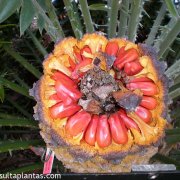Care of the cycad Encephalartos natalensis or Natal cycad |
|
The genus Encephalartos, family Zamiaceae, comprises 60 species of cycads native to Africa. Some species are: Encephalartos natalensis, Encephalartos lebomboensis, Encephalartos horridus, Encephalartos ferox, Encephalartos altensteinii, Encephalartos senticosus, Encephalartos villosus, Encephalartos lehmannii, Encephalartos transvenosus, Encephalartos aemulans, Encephalartos paucidentatus. Common names: Natal cycad, Giant cycad. This species is native to South Africa. They are large, arboreal cycads that reach 7 meters (22.96 feet) in height. The leaves are long (up to 3 meters), curved and are composed of bright green spiny leaflets. These dioecious plants produce large ovoid female cones that reach 60 cm (23.62") in height and 30 cm (11.8") in width; the male cones are cylindrical and velvety in texture. The seeds are bright red and appear in the female cones. Male plants and female plants are needed for pollination to occur. These relatively fast growing plants are used as isolated specimens due to their large size. When Natal cycad is young it can be grown in pots. Encephalartos natalensis can be grown in light shade or full sun exposure. It resists occasional light frosts. The soil can be a very well-drained garden substrate with siliceous sand and containing compost or leaf mulch. The transplant is done in early spring. Water moderately waiting for the substrate to be dry. In winter, reduce watering to a minimum, especially if it rains and they are grown outdoors. Fertilize in early spring with compost and once a month in spring and summer with mineral fertilizer. Giant cycad does not need pruning. Encephalartos natalensis is a resistant plant to the usual pests and diseases. Natal cycad propagates by seeds sown in spring in the nursery. They take more than 6 months to germinate. |
Images of the cycad Encephalartos natalensis or Natal cycad |
Find plants
Encephalartos natalensis or Natal cycad | Care and Growing
© 2025 FavThemes

